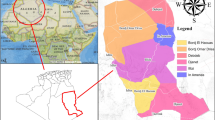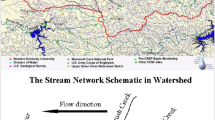Abstract
The real-time availability of key water quality parameters is of great importance for an advanced and optimized process control in wastewater treatment plants (WWTPs). However, due to the complex environment conditions and costly measuring instruments, it is generally difficult and time-consuming to measure certain key water quality parameters online, such as the effluent biochemical oxygen demand (BOD) and the effluent total nitrogen (TN). Recently, artificial neural networks have powered the online prediction tasks in several WWTPs. Hence, in this paper, an adaptive task-oriented radial basis function (ATO-RBF) network is developed to design prediction models for accurate timely acquirements of the effluent BOD and the effluent TN. The advantage of ATO-RBF network is that the architecture is not designed by human engineers; it is adaptively generated from the data to be processed. First, to enhance the learning ability and generalization performance of prediction models, an error correction-based growing strategy and a second-order learning algorithm are combined to design the ATO-RBF network. Then, RFB nodes with low significance would be pruned without sacrificing the learning accuracy, making the prediction model more compact. Additionally, the convergence of the ATO-RBF network is analyzed based on the Lyapunov criterion, which can guarantee its feasibility in practical applications. Finally, the proposed methodology is verified by benchmark simulations and real industrial data, showing superior prediction accuracy in compared with conventional methods.













Similar content being viewed by others
References
Van Loosdrecht M, Brdjanovic D (2014) Anticipating the next century of wastewater treatment. Science 344(6191):1452–1453
Olsson G, Carlsson B, Comas J et al (2014) Instrumentation, control and automation in wastewater—from London 1973 to Narbonne 2013. Water Sci Technol 69:1373–1385
Corominas L, Garrido-Baserba M, Villez K et al (2018) Transforming data into knowledge for improved wastewater treatment operation: a critical review of techniques. Environ Model Softw 106:89–103
Haimi H, Corona F, Mulas M et al (2015) Shall we use hardware sensor measurements or soft-sensor estimates? Case study in a full-scale WWTP. Environ Model Softw 72:215–229
Haimi H, Mulas M, Corona F, Vahala R (2013) Data-derived soft-sensors for biological wastewater treatment plants: an overview. Environ Model Softw 47:88–107
Olsson G (2012) ICA and me—a subjective review. Water Res 46:1585–1624
Kaelin D, Manser R, Rieger L et al (2009) Extension of ASM3 for two-step nitrification and denitrification and its calibration and validation with batch tests and pilot scale data. Water Res 43(6):1680–1692
Yang M, Sun P, Wang R et al (2013) Simulation and optimization of ammonia removal at low temperature for a double channel oxidation ditch based on fully coupled activated sludge model (FCASM): a full-scale study. Biores Technol 143:538–548
Harrou F, Dairi A, Sun Y, Senouci M (2018) Statistical monitoring of a wastewater treatment plant: a case study. J Environ Manage 223:807–814
Dürrenmatt DJÔ, Gujer W (2012) Data-driven modeling approaches to support wastewater treatment plant operation. Environ Model Softw 30:47–56
Xie Y, Yu J, Xie S et al (2019) On-line prediction of ferrous ion concentration in goethite process based on self-adjusting structure RBF neural network. Neural Netw 116:1–10
Xie S, Xie Y, Huang T et al (2019) Generalized predictive control for industrial processes based on neuron adaptive splitting and merging RBF neural network. IEEE Trans Ind Electron 66:1192–1202
Pandiyaraju V, Logambigai R, Ganapathy S et al (2020) An energy efficient routing algorithm for WSNs using intelligent fuzzy rules in precision agriculture. Wireless Pers Commun 112:243–259
Thangaramya K, Kulothungan K, Logambiga R et al (2019) Energy aware cluster and neuro-fuzzy based routing algorithm for wireless sensor networks in IoT. Comput Netw 151:211–223
Sethukkarasi R, Ganapathy S, Yogesh P, Kannan A (2014) An intelligent neuro fuzzy temporal knowledge representation model for mining temporal patterns. J Intell Fuzzy Syst 26(3):1167–1178
Han HG, Chen QL, Qiao JF (2011) An efficient self-organizing RBF neural network for water quality prediction. Neural Netw 24(7):717–725
Yang T, Zhang L, Wang A et al (2013) Fuzzy modeling approach to predictions of chemical oxygen demand in activated sludge processes. Inf Sci 235:55–64
Li D, Yang HZ, Liang XF (2013) Prediction analysis of a wastewater treatment system using a Bayesian network. Environ Model Softw 40:140–150
Han H, Qiao J (2013) Hierarchical neural network modeling approach to predict sludge volume index of wastewater treatment process. IEEE Trans Control Syst Technol 21:2423–2431
Guo H, Jeong K, Lim J et al (2015) Prediction of effluent concentration in a wastewater treatment plant using machine learning models. J Environ Sci (China) 32:90–101
Fernandez de Canete J, Del Saz-Orozco P, Baratti R et al (2016) Soft-sensing estimation of plant effluent concentrations in a biological wastewater treatment plant using an optimal neural network. Expert Syst Appl 63:8–19
Li F, Qiao J, Han H, Yang C (2016) A self-organizing cascade neural network with random weights for nonlinear system modeling. Appl Soft Comput 42:184–193
Zhu JJ, Kang L, Anderson PR (2018) Predicting influent biochemical oxygen demand: balancing energy demand and risk management. Water Res 128:304–313
Zaghloul MS, Hamza RA, Iorhemen OT et al (2018) Performance prediction of an aerobic granular SBR using modular multilayer artificial neural networks. Sci Total Environ 645:449–459
Cong Q, Yu W (2018) Integrated soft sensor with wavelet neural network and adaptive weighted fusion for water quality estimation in wastewater treatment process. Meas J Int Meas Confed 124:436–446
Meng X, Rozycki P, Qiao JF, Wilamowski BM (2018) Nonlinear system modeling using RBF networks for industrial application. IEEE Trans Ind Inf 14(3):931–940
Qiao JF, Wang L, Yang CL (2019) Adaptive lasso echo state network based on modified Bayesian information criterion for nonlinear system modeling. Neural Comput Appl 31:6163–6177
Yang C, Qiao JF, Wang L, Zhu X (2019) Dynamical regularized echo state network for time series prediction. Neural Comput Appl 31:6781–6794
Hunter D, Yu H, Pukish III et al (2012) Selection of proper neural network sizes and architectures—a comparative study. IEEE Trans Ind Inf 8(2):228–240
Goh PY, Tan SC, Cheah WP et al (2019) Adaptive rough radial basis function neural network with prototype outlier removal. Inf Sci 505:127–143
Yoon S, Jeon H, Kum D (2019) Predictive Cruise control using radial basis function network-based vehicle motion prediction and chance constrained model predictive control. IEEE Trans Intell Trans Syst 20(10):3832–3843
de Jesus RJ, Elias I, Cruz DR et al (2017) Uniform stable radial basis function neural network for the prediction in two mechatronic processes. Neurocomputing 227:122–130
Sharifipour M, Bonakdari H, Zaji AH (2018) Comparison of genetic programming and radial basis function neural network for open-channel junction velocity field prediction. Neural Comput Appl 30(3):855–864
Li H, Wang Y, Xu X et al (2019) Short-term passenger flow prediction under passenger flow control using a dynamic radial basis function network. Appl Soft Comput 83:105620
Alexandridis A, Chondrodima E, Sarimveis H (2016) Cooperative learning for radial basis function networks using particle swarm optimization. Appl Soft Comput 49:485–497
Emamgholizadeh S, Kashi H, Marofpoor I et al (2014) Prediction of water quality parameters of Karoon River (Iran) by artificial intelligence-based models. Int J Environ Sci Technol 11(3):645–656
Izonin I, Tkachenko R, Kryvinska N et al (2019) Committee of SGTM neural-like structures with RBF kernel for insurance cost prediction task. 2019 IEEE 2nd Ukraine conference on electrical and computer engineering, UKRCON 2019—Proceedings. p 1037−1040.
Tkachenko R, Tkachenko P, Izonin I et al (2019) Committee of the combined RBF-SGTM neural-like structures for prediction tasks. Lect Notes Comput Sci 11673:267–277
Tkachenko R, Kutucu H, Izonin I et al (2018) Non-iterative neural-like predictor for solar energy in Libya. ICTERI 1:35–45
Que Q, Belkin M (2020) Back to the future: radial basis function network revisited. IEEE Trans Pattern Anal Mach Intell 42:1856–1867
Qiao JF, Meng X, Li W (2018) An incremental neuronal-activity-based RBF neural network for nonlinear system modeling. Neurocomputing 302:1–11
Kadirkamanathan V, Niranjan M (1993) A function estimation approach to sequential learning with neural networks. Neural Comput 5(6):954–975
Yingwei L, SundararajanN SP (1997) A sequential learning scheme for function approximation using minimal radial basis function neural networks. Neural Comput 9(2):461–478
Huang GB, Saratchandran P, Sundararajan N (2004) An efficient sequential learning algorithm for growing and pruning RBF (GAP-RBF) networks. IEEE Trans Syst Man Cybern Part B Cybern 34(6):2284–2292
Huang GB, Saratchandran P, Sundararajan N (2005) A generalized growing and pruning RBF (GGAP-RBF) neural network for function approximation. IEEE Trans Neural Netw 16(1):57–67
Chen H, Gong Y, Hong X et al (2015) A fast adaptive tunable RBF network for nonstationary systems. IEEE Trans Cybern 46(12):2683–2692
Qasem SN, Shamsuddin SM, Zain AM (2012) Multi-objective hybrid evolutionary algorithms for radial basis function neural network design. Knowl Based Syst 27:475–497
Alexandridis A, Chondrodima E, Sarimveis H (2013) Radial basis function network training using a nonsymmetric partition of the input space and particle swarm optimization. IEEE Trans Neural Netw Learn Syst 24:219–230
Han HG, Lu W, Hou Y et al (2018) An adaptive-PSO-based self-organizing RBF neural network. IEEE Trans Neural Netw Learn Syst 29:104–117
Yu H, Reiner PD, Xie T et al (2014) An incremental design of radial basis function networks. IEEE Trans Neural Netw Learn Syst 25:1793–1803
Wu X, Rózycki P, Wilamowski BM (2015) A hybrid constructive algorithm for single-layer feedforward networks learning. IEEE Trans Neural Netw Learn Syst 26:1659–1668
Qian X, Huang H, Chen X et al (2017) Generalized hybrid constructive learning algorithm for multioutput RBF networks. IEEE Trans Cybern 47:3634–3648
Cortes C, Vapnik V (1995) Support-vector networks. Mach Learn 20(3):273–297
Huang GB, Chen L, Siew CK (2006) Universal approximation using incremental constructive feedforward networks with random hidden nodes. IEEE Trans Neural Netw 17:879–892
Vuković N, Miljković Z (2013) A growing and pruning sequential learning algorithm of hyper basis function neural network for function approximation. Neural Netw 46:210–226
Acknowledgements
This work was supported by the National Science Foundation of China under Grants 61903012, 61533002 and 61890930-5, the National Key Research and Development Project under Grant 2019YFC1906004-2, and the Beijing Natural Science Foundation under Grant 4204088.
Author information
Authors and Affiliations
Corresponding author
Ethics declarations
Conflict of interest
The authors declare that they have no conflict of interest.
Additional information
Publisher's Note
Springer Nature remains neutral with regard to jurisdictional claims in published maps and institutional affiliations.
Rights and permissions
About this article
Cite this article
Meng, X., Zhang, Y. & Qiao, J. An adaptive task-oriented RBF network for key water quality parameters prediction in wastewater treatment process. Neural Comput & Applic 33, 11401–11414 (2021). https://doi.org/10.1007/s00521-020-05659-z
Received:
Accepted:
Published:
Issue Date:
DOI: https://doi.org/10.1007/s00521-020-05659-z




